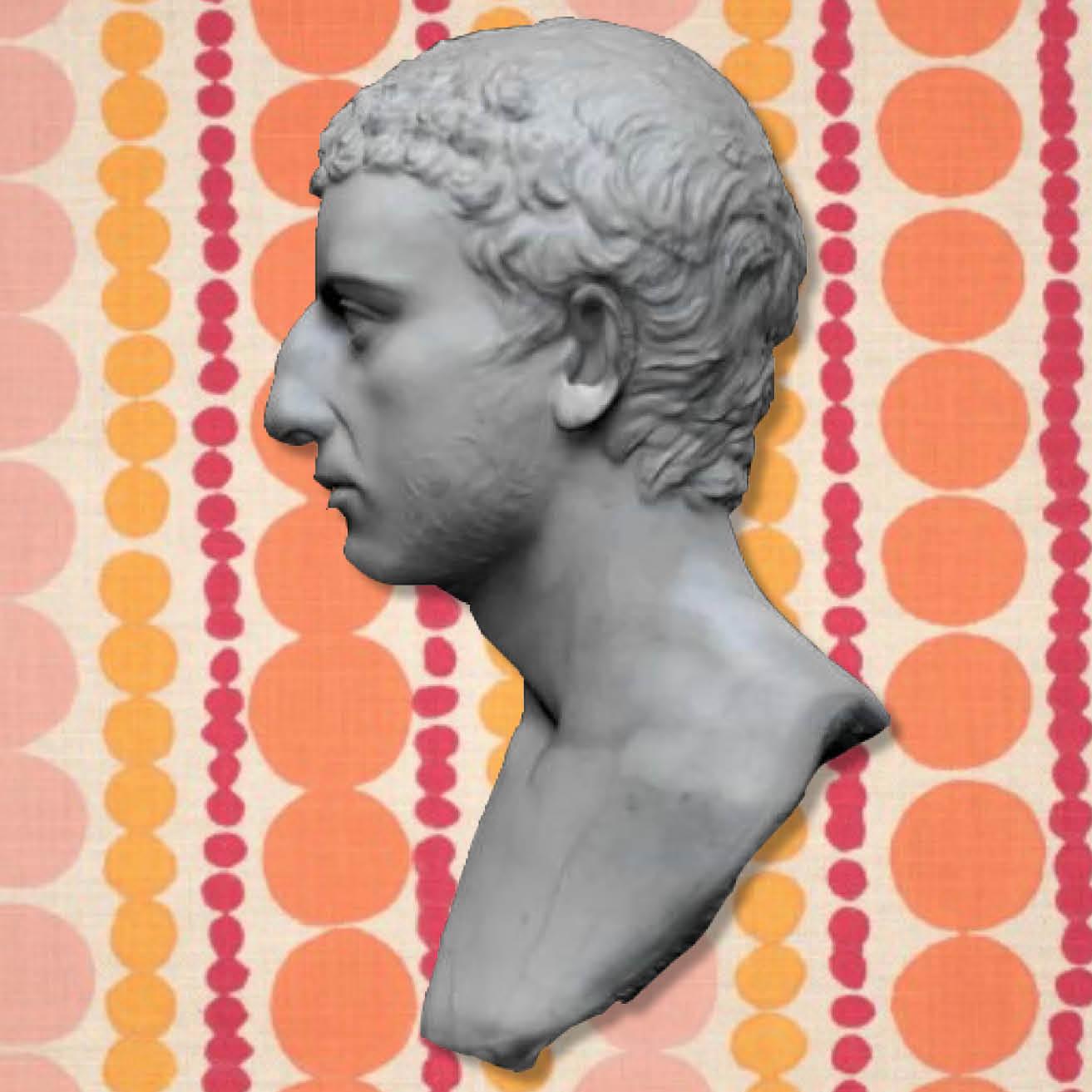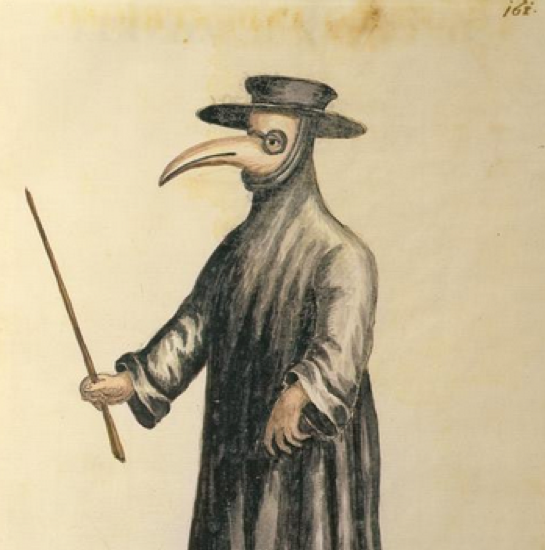Pandemic and Plague: Literary Encounters
In this JQR blog forum, the third in a series inspired by the COVID-19 pandemic, five scholars reflect on scenes from Jewish literature that allow them some purchase on this moment.
![Color copper engraving of Doctor Schnabel [i.e Dr Beak], a plague doctor in seventeenth-century Rome, published by Paul Fürst, ca. 1656.](https://katz.sas.upenn.edu/sites/default/files/styles/blog_wide_image/public/2020-05/JQR%20Forum%20on%20Literature_May%202020.png?itok=cSNU9OyJ)
JQR is pleased to present our third forum in a series offering scholarly meditations drawn from a range of disciplinary perspectives. In the first forum, five historians reflected on the existence and meaning of plagues in Jewish history; the second invited philosophers and theologians to share insights on the pandemic and its meaning. In this forum below we have asked five scholars to share insights gleaned from their reading of Jewish literature.
Literature is, at once, a site of refuge from the ravages of the outside world and a uniquely searing expression of it. The five authors below capture this double-edged quality of literature in the age of pandemic—all without mentioning Camus’s The Plague! Drawing on the riches of modern Hebrew and Yiddish literature, they help us recall that we are not the first to experience fear, illness, and disease. They also remind us of the manifold human responses to tragedy, some of which are worthy of emulation in our daily lives and others less so.
We will continue to draw upon the riches of Jewish studies and the talents of its practitioners to keep this precious scholarly legacy alive and relevant to today.
The Editors of JQR
Uneasy Knowledge
Laurence Roth
Charles B. Degenstein Professor of English, Susquehanna University
Sometime in April, a friend emailed me to ask what made Saul Bellow so culturally important. I was in no mood to answer, nor to take reading that seriously. I was too busy gulping down news online and listening to the radio’s thrum of fear and anger. I’d dutifully tried Psalm 91, “There shall no evil befall thee, / Neither shall any plague come nigh thy tent,” but the encouragement felt as stilted as the English translation. Instead, I dipped back into Tom Segev’s 1949 and binge-watched Babylon Berlin, Unorthodox, and Bojack Horseman on Netflix, looking for darkness even in laughter.
I admit, I'm generally not inspired by literature, only made more disconsolate by it. Which is why, though I’ve had no patience for him in years, Bellow’s famous last line, “We know, we know, we know,” is always in my ears, especially now. Not because I believe it. Because it seems such a pitiable sentiment. In the hospital wards and unemployment lines who can deny we have an ethical obligation to others? Yet how can we be certain about anything in the face of mass death and political dysfunction?
So I recommended my friend read “The Old System,” forgetting that the line is actually from Mr. Sammler’s Planet. Perhaps I confused the two since they end the same way, both Mr. Sammler and Dr. Braun lamenting our existential blindness even as they grasp at the dim possibility of reaching some understanding about it. Such hope, I think. Such beautiful nonsense.
Scholarship and Contagion
Lital Levy
Associate Professor of Comparative Literature, Princeton University
What is meaningful to me is continuing to work on texts I enjoy, with no connection to the current situation. However, I do find myself rethinking one work I have read, discussed, thought through, and written about with both colleagues and students: S. Y. Agnon’s enigmatic 1954 story “‘Ad ‘olam” (Forevermore). Only now do I really feel this piece: where once I saw it as a bizarre and intriguing parable, it now feels to me as though written for this moment. The narrative brings us into Jerusalem polite society, an apocryphal medieval city, and a leper hospital: its themes move between scholarly method and academic politics, erudition and obsession. A reclusive, nebbish-y man, oblivious to the social life of the academy, devotes himself single-mindedly for twenty years to a meticulous, authoritative history of the destroyed medieval city of Gumlidata. He is haunted by the one detail of Gumlidata’s history that has eluded him: How did the invading Goths penetrate the city walls? Just when he has despaired of bringing his research to light, a rich industrialist invites him to discuss publishing his book. With great excitement, he prepares for the meeting, and has one foot out the door when a nurse from the city’s leper hospital shows up on her annual rounds to collect reading material for her charges. Inexplicably, the scholar tarries, torn between his urgent need to keep the appointment and a strangely paralyzing, seemingly self-destructive desire (that practically begs psychoanalytical readings) to continue conversing with the nurse. Offhandedly, in the course of conversation, the nurse mentions a worn-out, moldy book in the leper house, besmirched by generations of lepers’ tears; “As far as what is written in it, I’ve heard that it contains the history of a city which was destroyed and disappeared from the face of the earth.” To his amazement, the scholar soon realizes that she is speaking of a manuscript history of his own Gumlidata. He abandons the appointment without a second thought, follows her back to the leper hospital, argues his way in, and insists on access to the contaminated book, which presumably infects him. The story (translated by Joel Blocker for Commentary in 1961) ends with a sly, disingenuous, and disturbing fairy tale-like ending in which the scholar, seduced by Wisdom, enters a timeless state of study in the leper house, where he remains “forevermore.”
The story has inspired numerous interpretations, some based on ideas of a national allegory or messianism. In light of the current moment, I have begun thinking about plague and leprosy less as ciphers for the story’s hidden meaning and more as the meaning itself. What I now see is that it is also a story about conducting scholarship in isolation. Even before the encounter with the nurse, the scholar writes his magnum opus at home, in near complete isolation. Arguably, in leaving his home for the leper hospital, he moves to a less solitary form of isolation (at least in the leper hospital, he has the company of the other lepers). Furthermore, Agnon implies that in this case, at least, true knowledge comes at the cost of staying in the leper colony “forevermore.” Scholarship and leprosy, knowledge and contagion, truth and isolation: is there anything more suggestive and evocative for the work of scholarship in an age of pandemic? Granted, given our digitally connected lives, we are not truly isolated—but psychologically, many of us may still feel that we are currently living on islands. What does it mean to pursue scholarship and discovery while in a state of quarantine and isolation? Is human knowledge fundamentally about isolated, platonic truths, or is it a dynamic conversation dependent on social connection?
Let’s Talk about Something More Cheerful
Hana Wirth-Nesher
Professor Emerita of English and American Studies, Tel Aviv University
After Tevye tells Sholem Aleichem the whole tragic story of his daughter Hodel’s marriage to the Russian revolutionary Perchik, his arrest and imprisonment, and the parting of father and daughter for what may be a lifetime as she flees to be near his side, he delivers one of the most famous lines in this author’s oeuvre. “And now let’s talk about something more cheerful. Tell me, what’s the news about the cholera in Odessa?” I have always understood the cholera epidemic, a historical fact in the Russian Empire, to be just a cynical remark that Sholem Aleichem gave to Tevye to express the grimness of life for Jews in this period. For me, cholera could have been replaced by any other misery in Tevye’s world, because this line’s function was to convey the character’s wry sense of humor, and in a broader sense, Jewish humor and irony as survival strategies.
Over the past two months, this phrase has been echoing in my mind, and for the first time I have been reflecting on its actual content. On one hand, Tevye’s remark is tongue-in-cheek; cholera is far from being a cheerful topic. Yet, on the other hand, for this heartbroken father, on the scale of misery cholera is not as tragic as his daughter’s zealous allegiance to revolution, to her husband’s radicalism. Hodel followed her heart, which meant that she chose to be a martyr for an ideology. Tevye’s profound sorrow could have been prevented if she had chosen differently. While the loss of a child, whether through disease or lifelong separation, results in profound sadness, Tevye’s tragedy is compounded by causation, by his children’s political choices. Tevye’s sardonic humor, therefore, partly depends on a separation between tragedy brought on by human beings’ actions and tragedy brought on by forces of nature. While cholera may not be a cheerful topic, in his eyes it is less fraught than voluntary self-destruction. As the Corona pandemic evolves, I am struck by how it compels us to humbly face humanity’s lack of control over nature, while at the same time I have come to realize how agency, choice, and leadership (or lack of it) are also causes of its tragic trail of loss. Tevye’s bitter humor reflects his understanding that a plague may be attributed to divine forces, but a revolution is a man-made disease that could have been averted. In his world view, biology and ideology are parallel lines, yet for us they have intersected.
But let’s talk about something more cheerful.
"The Pot" in the Time of Pandemic
Sunny Yudkoff
Assistant Professor in the Department of German, Nordic, and Slavic and at the Mosse/Weinstein Center for Jewish Studies, University of Wisconsin-Madison
Sholem Aleichem’s 1901 monologue “The Pot” (Dos tepl) is not a work that will provide any solace or break from thinking about illness. It lacks the reassuring medical positivism of a doctor-hero narrative and the dramatic points of recognition of a patient-memoir. Instead, it does something more useful: it yells.
“The Pot” refuses to be quiet in the face of incurable sickness. The protagonist—Yente the dairy-vender and poultry-dealer—accosts a speechless rabbi with a complicated tale concerning a drop of milk that might have touched a fleyshik pot. The story of the now potentially-unkosher crockware, though, is merely an excuse for Yente to narrate her dire situation: her son is suffering from tuberculosis—the same disease that killed her husband—and there is no medical, intellectual, or religious cure available. All Yente’s hopes rest on making a chicken broth for her son, as prescribed somewhat condescendingly by the local doctor. But the kosherness of the pot is moot. Yente the poultry woman can barely afford even a quarter chicken. The rabbi might be able to tell her if her pot is kosher, but he has no answer to poverty or tuberculosis. His final gesture, both cruel and kind, is to spare himself and Yente by interrupting her—not with a response but with his own health emergency. The story concludes with the rabbi on the verge of fainting, as Yente cries out for help.
This is a text that captures desperation of health, class, family, community, and belief. In this moment of COVID-19, in this time of disquiet, disturbance, and non-answers, Yente’s voice won’t stop ringing in my ears.
Solidarity in Times of Crisis
Avner Holtzman
Professor of Hebrew Literature and Jacob and Shoshana Schreiber Chair in Contemporary Jewish Culture, Tel Aviv University
The Hebrew Novel Miriam (1920–21) is Micha Yosef Berdyczewski’s final and most ambitious work. It was conceived as a memorial to the dying world of the Ukrainian shtetl that was cruelly destroyed in a series of pogroms during the Russian Civil War (especially 1918–20). The original intention was to create a coherent, traditional novel, but the final product became a wild and enigmatic modernist composition, a seemingly unruly cluster of tiny, loosely connected stories. The heroine herself, Miriam, ponders the riddles of the world, whose properties and laws seem to her a collection of incomprehensible signs.
Readers of Hebrew literature were fascinated by the lyrical nature of the novel, but like Miriam herself, found it difficult to decipher the organizing principles of the world it depicts. However, the resolution that brings the novel to a close emerges from that same perplexity. After wondering about her purpose in life, Miriam finds salvation in the religious and ethical teachings of Leo Tolstoy. Under the influence of the great Russian author, she decides to devote herself to the needy. She approaches the old town doctor, Koch (perhaps an allusion to the great microbiologist Robert Koch, whose discoveries led to the eradication of tuberculosis and other infectious diseases), and offers to be of service to him. This surprising gesture functions as an antidote to the turbulent reality the novel constructs. The heroine's existential decision casts moral meaning upon the absurd reality surrounding her.
Exactly a century later, as the certainty of our existence is undermined, one of the brightest lights we witness is the noble devotion of medical teams, endangering their lives and arousing feelings of awe and gratitude throughout the world. In this atmosphere of human solidarity in time of global crisis, Berdyczewski’s beautiful novel deserves to be read again.
Image caption: Color copper engraving of Doctor Schnabel [i.e Dr Beak], a plague doctor in seventeenth-century Rome, published by Paul Fürst, ca. 1656.



